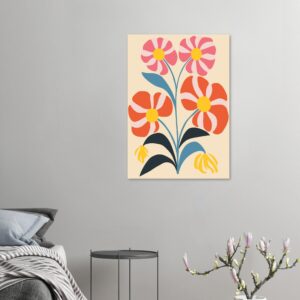Abstract Wall Art: A Modern Masterpiece
In recent years, abstract wall art has surged in popularity, becoming a staple in modern interior design. This trend reflects a broader cultural shift towards individual expression and the desire for unique, personalised spaces. Unlike traditional art forms that often depict recognisable subjects, abstract art invites viewers to engage with colours, shapes, and forms on a more emotional and intuitive level.
This shift has been fueled by the rise of social media platforms like Instagram and Pinterest, where visually striking images can quickly gain traction and inspire countless homeowners and designers alike. The appeal of abstract wall art lies in its versatility and ability to complement a wide range of design aesthetics. Whether a space is minimalist, bohemian, or industrial, abstract pieces can enhance the overall ambiance without overwhelming the existing decor.
The use of bold colours and dynamic compositions can serve as focal points in a room, drawing the eye and sparking conversation. As more people seek to create environments that reflect their personal tastes and lifestyles, abstract wall art has emerged as a powerful tool for achieving that goal.
Key Takeaways
- Abstract wall art has become a popular choice in modern interior design, adding a unique and contemporary touch to any space.
- Abstract art is meant to evoke emotion and stimulate the imagination, serving as a form of expression and interpretation for both the artist and the viewer.
- There are various styles and techniques in abstract wall art, including geometric, minimalist, and expressionist, each offering a different aesthetic and visual impact.
- When choosing abstract wall art, consider the size, colour scheme, and overall theme of the space to ensure a cohesive and harmonious look.
- Abstract wall art can be incorporated into different rooms of the home, from the living room to the bedroom, creating a dynamic and personalised atmosphere in each space.
Understanding the Meaning and Purpose of Abstract Art
Abstract art is often misunderstood, with many perceiving it as mere randomness or chaos. However, at its core, abstract art serves a profound purpose: to evoke emotions and provoke thought without relying on literal representation. Artists who work in this genre often aim to express complex ideas or feelings that may be difficult to articulate through traditional means.
By stripping away recognisable forms, they invite viewers to interpret the work through their own experiences and emotions, creating a deeply personal connection. The purpose of abstract art extends beyond mere decoration; it can also serve as a catalyst for introspection and dialogue. In a world saturated with visual stimuli, abstract pieces can provide a moment of pause, encouraging viewers to reflect on their own perceptions and interpretations.
This engagement can lead to a richer understanding of both the artwork itself and the viewer’s own emotional landscape. As such, abstract wall art can transform a space into a sanctuary for contemplation and creativity.
Exploring Different Styles and Techniques in Abstract Wall Art
The realm of abstract wall art is vast and varied, encompassing numerous styles and techniques that cater to diverse tastes. One prominent style is geometric abstraction, characterised by the use of shapes, lines, and forms arranged in a structured manner. Artists like Piet Mondrian and Kazimir Malevich pioneered this approach, emphasising balance and harmony through precise compositions.
Geometric abstraction often appeals to those who appreciate order and symmetry in their surroundings. Another significant style is gestural abstraction, which emphasises the physical act of painting itself. This technique often involves bold brushstrokes, drips, and splatters that convey energy and movement.
Artists such as Jackson Pollock and Willem de Kooning exemplified this approach, creating works that celebrate spontaneity and the artist’s emotional state at the moment of creation. Gestural abstraction can infuse a space with dynamism and vitality, making it an excellent choice for areas where creativity and inspiration are paramount.
How to Choose the Perfect Abstract Wall Art for Your Space
Selecting the right abstract wall art for your home involves careful consideration of several factors, including colour palette, size, and overall aesthetic. One of the first steps is to assess the existing decor in your space. The artwork should harmonise with the colours and textures already present while also providing a striking contrast or focal point.
For instance, if your room features neutral tones, a vibrant piece with bold colours can create an eye-catching centerpiece that enlivens the space. Size is another crucial element in choosing abstract wall art. A large canvas can dominate a room and serve as a statement piece, while smaller works can be grouped together to create a gallery wall effect.
When selecting size, consider the scale of your furniture and other decor elements; oversized art may overwhelm a small room, while tiny pieces may get lost in a larger space. Additionally, think about the placement of the artwork—hanging it at eye level ensures that it is easily appreciated by viewers.
Incorporating Abstract Wall Art into Different Rooms of Your Home
Abstract wall art can be seamlessly integrated into various rooms throughout your home, each space offering unique opportunities for expression. In living rooms, large-scale pieces can serve as conversation starters while enhancing the overall aesthetic. A bold abstract painting above a sofa can create a striking focal point that draws attention and invites guests to engage with the artwork.
Additionally, incorporating complementary decor elements—such as throw pillows or rugs that echo colours from the artwork—can create a cohesive look. In bedrooms, abstract wall art can contribute to a calming atmosphere conducive to relaxation. Soft colour palettes and gentle forms can evoke tranquility, making them ideal choices for this intimate space.
Consider placing smaller pieces on bedside tables or above dressers to create a serene environment that promotes restful sleep. In contrast, vibrant and energetic pieces may be more suitable for home offices or creative spaces where inspiration is key.
The Impact of Abstract Wall Art on Mood and Atmosphere
The presence of abstract wall art in a space can significantly influence mood and atmosphere. colours play a pivotal role in this dynamic; warm hues like reds and oranges can evoke feelings of energy and passion, while cooler tones such as blues and greens tend to promote calmness and serenity. By thoughtfully selecting artwork that aligns with the desired emotional tone of a room, homeowners can create environments that support their lifestyle needs.
Moreover, abstract art’s inherent ambiguity allows for personal interpretation, which can further enhance its impact on mood. Viewers may find themselves drawn to specific pieces based on their own experiences or emotions at any given moment. This connection fosters an environment where individuals feel understood and validated in their feelings.
As such, incorporating abstract wall art into your home can transform it into a sanctuary that nurtures emotional well-being.
Investing in Quality Abstract Wall Art: Tips and Considerations
When investing in abstract wall art, quality should be a primary consideration. Original pieces created by established artists often carry more value than mass-produced prints or reproductions. Researching artists’ backgrounds, techniques, and exhibitions can provide insight into their work’s significance and potential appreciation over time.
Additionally, purchasing from reputable galleries or directly from artists ensures authenticity and supports the creative community. Another important factor is the medium used in the artwork. Paintings created with high-quality materials—such as professional-grade acrylics or oils—tend to have greater longevity than those made with inferior supplies.
Similarly, consider the framing options available; well-framed pieces not only enhance visual appeal but also protect the artwork from damage over time. Investing in quality materials ultimately contributes to the overall value of your collection.
Creating a Statement with Abstract Wall Art in Your Home
To create a statement with abstract wall art in your home, consider curating a collection that reflects your personal style while also making an impact on viewers. A well-thought-out arrangement of pieces can transform an ordinary wall into an extraordinary gallery-like experience. Experimenting with different sizes, orientations, and framing styles can add depth and interest to your display.
Additionally, consider incorporating mixed media elements into your collection to further enhance its visual appeal. Combining paintings with sculptures or textile art can create a dynamic interplay of textures and forms that captivates the eye. By thoughtfully selecting and arranging abstract wall art throughout your home, you not only showcase your unique taste but also create an environment that inspires creativity and conversation among guests.









Add comment